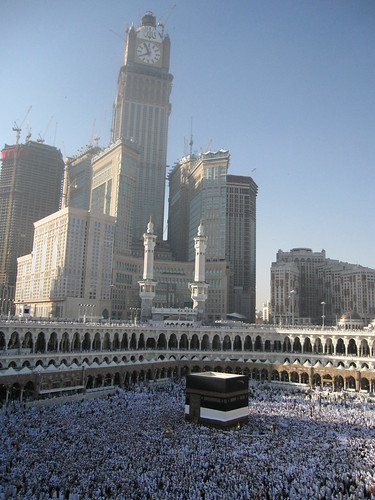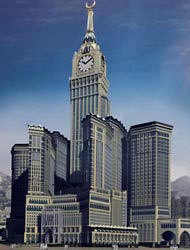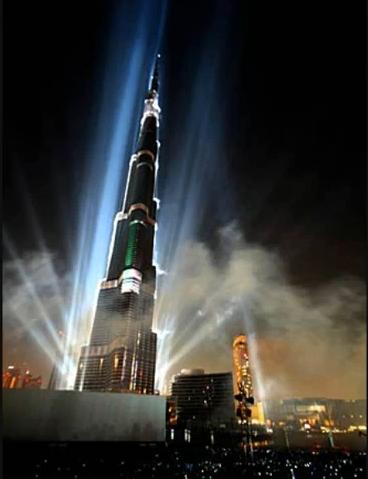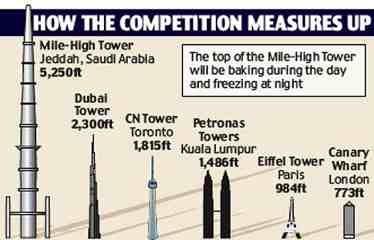A Mecca for high-rise projects till 2020
 |
| Add caption |
- The world's tallest clock tower, a hybrid of Big Ben and the Empire State Building, hovers above Muslim pilgrims as they walk around the Kaaba in Mecca, Islam's most sacred site.
 |
| The Mecca Royal Clock Tower |
Saudi Arabia is capitalising on the world's growing Muslim population by developing massive tracts in and around its holy sites and has identified religious tourism as a way of diversifying its economy.
Since Mecca sits in a narrow valley, plans include levelling the surrounding mountains and building skyscrapers to house residents and pilgrims.
The haram, or sacred complex, which houses the Kaaba inside the Grand Mosque (pictured), the focal point of religious observance for Muslims, is also being expanded to create multiple storeys. And a fan-shaped mosque named after King Abdullah, the reigning monarch, and designed to be the world's largest, is being built to the north of the complex.
"The intention is to build a gigantic ring around the north and west side of the mosque . . . The only fixed points which have to be respected are the Kaaba and Safa and Marwah," says an architect who has worked on the extensions. Safa and Marwah are points between which pilgrims pass seven times to perform the pilgrimage.
"The two points can be extended vertically into space . . . The only way it can go is up. All of this is designed to increase the capacity of the mosque," the architect says.
The scale and aesthetics of the redevelopment have met with criticism locally and overseas but in November, Prince Khalid Al Faisal, the governor of Mecca Province, said the city had changed throughout its history and must be developed to accommodate the increasing numbers of Muslims eager to perform their holy duty. "Pilgrimage is a physically demanding journey, and we are trying to make it easier so that Muslims will focus more on the rituals," the prince said.
Hajj, the pilgrimage to Mecca, is one of the main five pillars of Islam and it is required once in a lifetime for those who are physically and financially capable.
According to Jones Lang LaSalle, a real estate consultancy, religious tourism to Saudi Arabia is projected to increase from 7.8m to 13.75m by 2019, and the number of hotel rooms in Mecca could double to 100,000.
Visitors to the holy cities often complain that tour operators charge them at five-star rates even when they use cheaper lodgings. In addition, travel agents say hotels over-book rooms because Saudi embassies sometimes do not issue visas in sufficient time.
When pilgrims do make it to the holy cities of Mecca and Medina, most accommodation is not regarded as meeting international standards. "There is a clear need to increase supply," says one tour operator.
For investors, the boom and bust cycles typical elsewhere may not apply, given the unique characteristics of the two cities, says Jones Lang LaSalle.
In the vicinity of the cities, a tight housing market is made more expensive because the Saudi government operates a quota system of visas for pilgrims from overseas. There are insufficient slots to meet demand and so some wealthier foreigners invest in property to gain access.
Although foreigners are restricted from owning land, some restrictions appear to have been relaxed, and many have invested in joint ventures with Saudi developers, in spite of legal uncertainties.
Fears of pandemics such as swine flu reduced the number of pilgrims to about 2.5m last year, and the financial crisis slowed projects such as Jabal Omar, another large-scale high-rise development to the west of the haram. But the pace of construction continues and the flow of pilgrims remains immense.
Mecca 2020, a government-sponsored plan, offers glimpses of the scale of the plans for the city, featuring a sprawl of steel and glass towers looming over the haram. Transport is being upgraded, with new monorail and rail routes intended to link Mecca and Medina.
"What is changing is that the government is spending more on infrastructure than before,'' says John Harris, head of Jones Lang LaSalle in Saudi Arabia. "There is substantial foreign interest. Malaysian companies are typically interested in building, operating and transferring ownership in 25-year projects.''
But experts note that the history of Mecca has raised special issues, particularly given the number of people claiming interests in plots.
"Sometimes many different ownership deeds apply to the same plot, based on claims from different countries," says Hazim Al Madani, a lawyer. "This is the most valuable real estate in the world, and when every metre is worth millions, everyone wants their spot."
By Abeer Allam
Description
The Makkah Clock Royal Tower hotel will have 76 storeys be 577 metres high, and will feature a 40-metre clock that be more than five times larger than Big Ben. The hotel, which is scheduled to open in September, will be the focal point of the Abraj Al Bait complex, part of the King Abdul Aziz Endowment Project. Fairmont Hotels will manage the new hotel. The project should be complete by the end of 2008.
The Royal Clock will announce daily prayers to the Muslim world and the Lunar Observation Center and Islamic Museum will serve to protect the heritage for future generations.
 |
| Floors 76 Height(m) 577 Height(ft)1893 |
Ketinggiannya kurang sedikit sahaja dari bangunan tertinggi di dunia Burj Khalifa Tower - Dubai
 |
| Floors160 Height(m) 828 Height(ft) 2717 |
Ketinggiannya kurang sedikit dari bangunan tertinggi di dunia Burj Khalifa Tower - Dubai |
next
Mile High Tower (working name) - Jeddah
Height(m) 1600 Height(ft) 5250 Builder Kingdom Holdings
Description
It is being planned for a new city near the Red Sea port of Jeddah. Behind the scheme is 51-year-old Prince al-Walid bin Talal, who bought the Savoy for £1.25billion in 2005.
The plan gives the Middle East a clear lead over Asian countries and the U.S., who have vied in the past to construct the world's tallest buildings.
 |
None of the other skyscrapers under construction, including New York's Freedom Tower on the World Trade Centre site, will exceed 2,296ft.
Experts say the technical challenges are enormous. Much of the lifting will be carried out by helicopters, which will also be used as commuter transport for builders.
The tower will have to be capable of withstanding a wide range of temperatures, with its top baking in the desert sun by day but dropping to well below freezing at night.
To resist the strong winds prevalent in the area and stop it swaying, giving its occupants a form of high-rise seasickness, it will be fitted with a giant computer-operated damper.
Two "mini-towers" - both taller than Canary Wharf - will be built on either side of the main tower.
Linked to it by elevated walkways, they will anchor it and act as stabilisers.
Until recently, the still-under-construction Dubai Tower was expected to be the world's tallest building.
Plans have changed several times to make it higher, but the final version is expected to be 2,300ft with 160 storeys.
UPDATE
MEED says tenders are expected by August 2008, following an "imminent" final investment decision on the project. A source close to the project told the publication: "It is generally understood that the project is going forward. It has not stopped and we don't think it is going to be stopped. The prince (Al-Waleed bin Talal) has indicated he is ready." If this is true and construction does go ahead, then it will be approximately twice the height of the current tallest structure, the Burj Dubai.
However, in May 2008 MEED reported that the project has been scaled back. It could be "up to 500 meters shorter" the article stated. Soil testings in the area recently delayed the first phases of the project casting doubt over whether skyscrapers of significant height can be built in the proposed location."
Clock Tower in Mecca draws criticism
By IBTimes Staff Reporter | December 31, 2010 7:31 AM EST
 |
The recent architectural developments surrounding the Grand Mosque in Mecca, regarded as the holiest site of the Muslim world, particularly in connection with the recently developed Royal Mecca Clock Tower have sparked off heated debates.
 |
| Muslim pilgrims pray inside the Grand Mosque, with the Mecca Clock lit up in the background, on the first day of the fasting month of Ramadan in Mecca. |
 |
Some regard them as "architectural absurdity", some as a sham to the age-old local customs and traditions of the Islam community - new architectural developments in and around the city have been drawing the attention of the world and raising speculations on the motive behind the constructions.
Officials of the Saudi government however maintain that the constructional changes are essential to accommodate the ever-increasing pilgrims that come to visit the Holy place.
But the high prices that people have to pay for the exclusive towers make prompted questions if officials were really working towards promoting the Hajj pilgrimage or whether it is all about commercialization.
Officials of the Saudi government however maintain that the constructional changes are essential to accommodate the ever-increasing pilgrims that come to visit the Holy place.
But the high prices that people have to pay for the exclusive towers make prompted questions if officials were really working towards promoting the Hajj pilgrimage or whether it is all about commercialization.
The Royal Mecca Clock Tower is just one of the many construction projects in the city, states the New York Times. From high-end luxury hotels to train lines; government officials are working on major expansion around the Grand Mosque.
The tower houses an enormous shopping mall, a prayer hall that can accommodate thousands of people and 800 luxury rooms. The entire structure has been designed to resemble the famed four-faced chiming clock, Big Ben, located at the Palace of Westminster in London. Arabic inscriptions and a crescent-shaped spire adorn the top of the tower.
A number of high rises and luxury towers are also being constructed adjoining the tower, all designed to give a contemporary feel.
A direct impact of the architectural developments is that a clear line of demarcation has been established wherein the wealthy can pay homage to the Holy land by merely looking through their windows while the other pilgrims continue with the usual custom of following the crowd.











0 comments:
Post a Comment